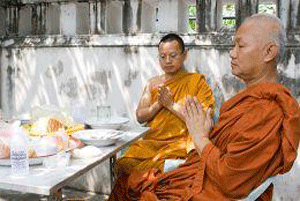 Water Chestnut Cake
Water Chestnut Cake
Typically made during preparations for the New Year, this treat was kept on hand for the many guests who would stop by to visit. Slightly similar to a turnip cake, though with a more jellylike texture and a sweet flavor, it’s made from canned water chestnuts and water chestnut flour, both of which are available at Chinese markets. The batter is poured into a round cake pan and steamed in a wok, then sliced and served warm. “Be sure to begin with the water boiling, keep the heat on high, and add more boiling water as needed,” says Lo. “You’ll probably need to add about one and a half cups every 20 minutes, as the steam is absorbed by the cake. To avoid burning yourself, turn off the heat before removing the lid, then turn the heat back on high once you’ve replaced it.”
Fried Oysters
In Buddhist tradition, eating meat, seafood, or dairy products is forbidden, but there are three shellfish that are permissible: clams, mussels, and oysters. Because the name for oysters sounds like the Chinese words for good business, they “were invariably served at meals during the New Year observance,” writes Lo. This simple method of frying them, one of her grandmother’s favorites, produces a crisp exterior and juicy interior. “A sauce is not necessary,” says Lo. “It would take away from the pure oyster flavor.” Before coating the oysters in the batter, be sure to pat them dry with a paper towel.
Clams Steamed with Ginger and Scallions
Another type of shellfish that’s acceptable for Buddhist vegetarians, the clam, with its open shell, symbolizes prosperity and thus is popular at the New Year. “Use Manila clams or another small variety,” advises Lo. “To avoid toughness, remove them as soon as they open so they don’t get overcooked.” Here also it’s important to start with boiling water and keep the heat on high, which will cook the clams quickly and leave them tender.
Perfect Cooked Rice
The traditional accompaniment for dishes like the clams—and, indeed, most Cantonese meals—is white rice. “This was the first thing that my grandmother taught me to cook,” says Lo. “I still make it exactly the same way today. This method gives you perfectly fluffy, separated grains.” Her technique calls for soaking the rice in water for an hour; boiling it, uncovered, until the water is absorbed; then covering the pot and cooking it over low heat for eight minutes more. Loosening the rice as soon as it’s done with a wooden spoon or chopsticks will help keep it fluffy.
Noodles with Young Ginger
“Noodles are served at the New Year because they represent longevity,” says Lo. “They’re usually the last dish of the banquet. We never cut the strands, because that would be cutting short your life.” To keep them perfectly al dente, be sure to plunge the noodles immediately into ice water as soon as they’re done. Then drain them in a strainer, loosening with chopsticks to prevent sticking. “If you’re short on time,” says Lo, “you can boil and drain them ahead of time. Then toss them with a little sesame oil to keep them from clumping together.” This recipe calls for eggless noodles, permissible to Buddhists, but if you don’t avoid dairy products, regular egg noodles can be substituted. “Both kinds are available at Chinese markets,” says Lo. “Egg noodles are yellow and the eggless kind are whitish.”
The article is originating from http://shine.yahoo.com




